序列检测器设计
EDA实验报告实验三、序列检测器的设计

实验三、序列检测器的设计一、预习内容1、预习序列发生器和检测器的基本工作原理;2、画出实验原理草图;3、写出实验的基本步骤和源程序。
二、实验目的1、掌握序列检测器的工作原理;2、学会用状态机进行数字系统设计。
三、实验器材PC机一台、EDA教学实验系统一台、下载电缆一根(已接好)、导线若干四、实验要求1、检测连续4个‘1’的状态机,画出状态转移图,并写出VHD代码;(必做部分)2、了解试验箱,完成数据分配器的硬件实验。
(实验一的硬件操作,首次使用请谨慎使用试验箱!)3、检测“10001110”序列,当检测到该序列后输出为‘1’。
(此部分选作)五、实验原理和实验内容1、序列发生器原理(此部分选作)在数字信号的传输和数字系统的测试中,有时需要用到一组特定的串行数字信号,产生序列信号的电路称为序列信号发生器。
本实验要求产生一串序列“10001110”。
该电路可由计数器与数据选择器构成,其结构图如图6-1所示,其中的锁存输出的功能是为了消除序列产生时可能出现的毛刺现象:图6-1 序列发生器结构图2、序列检测器的基本工作过程:序列检测器用于检测一组或多组由二进制码组成的脉冲序列信号,在数字通信中有着广泛的应用。
当序列检测器连续收到一组串行二进制码后,如果这组码与检测器中预先设置的码相同,则输出1,否则输出0。
由于这种检测的关键在于正确码的收到必须是连续的,这就要求检测器必须记住前一次的正确码及正确序列,直到在连续的检测中所收到的每一位码都与预置的对应码相同。
在检测过程中,任何一位不相等都将回到初始状态重新开始检测。
状态图如图6-2所示:图6-2 序列检测器状态图3、状态机的基本设计思想:在状态连续变化的数字系统设计中,采用状态机的设计思想有利于提高设计效率,增加程序的可读性,减少错误的发生几率。
同时,状态机的设计方法也是数字系统中一种最常用的设计方法。
一般来说,标准状态机可以分为摩尔(Moore)机和米立(Mealy)机两种。
EDA序列检测器设计课程设计
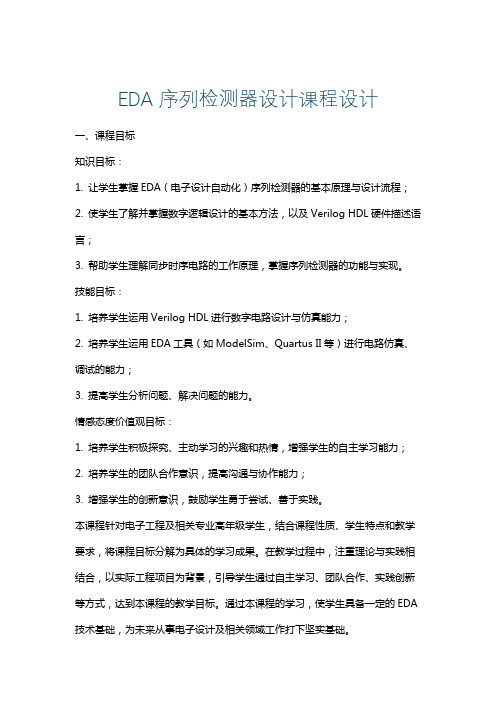
EDA序列检测器设计课程设计一、课程目标知识目标:1. 让学生掌握EDA(电子设计自动化)序列检测器的基本原理与设计流程;2. 使学生了解并掌握数字逻辑设计的基本方法,以及Verilog HDL硬件描述语言;3. 帮助学生理解同步时序电路的工作原理,掌握序列检测器的功能与实现。
技能目标:1. 培养学生运用Verilog HDL进行数字电路设计与仿真能力;2. 培养学生运用EDA工具(如ModelSim、Quartus II等)进行电路仿真、调试的能力;3. 提高学生分析问题、解决问题的能力。
情感态度价值观目标:1. 培养学生积极探究、主动学习的兴趣和热情,增强学生的自主学习能力;2. 培养学生的团队合作意识,提高沟通与协作能力;3. 增强学生的创新意识,鼓励学生勇于尝试、善于实践。
本课程针对电子工程及相关专业高年级学生,结合课程性质、学生特点和教学要求,将课程目标分解为具体的学习成果。
在教学过程中,注重理论与实践相结合,以实际工程项目为背景,引导学生通过自主学习、团队合作、实践创新等方式,达到本课程的教学目标。
通过本课程的学习,使学生具备一定的EDA 技术基础,为未来从事电子设计及相关领域工作打下坚实基础。
二、教学内容1. 序列检测器原理:介绍序列检测器的基本概念、功能、分类及其在数字系统中的应用。
- 教材章节:第三章第二节- 内容:同步时序电路原理,序列检测器设计方法。
2. Verilog HDL基础:讲解Verilog HDL硬件描述语言的基本语法、数据类型、运算符和建模方法。
- 教材章节:第四章- 内容:模块化设计,行为描述与结构描述,组合逻辑与时序逻辑描述。
3. 序列检测器设计:结合实例,分析序列检测器的设计方法与步骤。
- 教材章节:第五章第三节- 内容:Mealy型与Moore型序列检测器设计,状态编码,状态转移图。
4. EDA工具应用:介绍ModelSim、Quartus II等EDA工具的使用,进行电路仿真与调试。
实验三 序列信号检测器的设计

实验三序列信号检测器的设计一、实验目的:1、理解序列信号检测器的工作原理;2、掌握原理图和文本输入的混合设计输入方法;3、理解状态划分;4、掌握状态机程序的编写方法;二、实验原理:序列检测器是时序数字电路中非常常见的设计之一。
它的主要功能是:将一个指定的序列从数字码流中识别出来。
接下来的设计就是针对“011”这个序列的检测器。
设input为数字码流输入,output为检出标记输出,高电平表示“发现指定序列”,低电平表示“没有发现指定的序列”。
设输入的码流为“001101101111011111...”,在时钟2~4中,码流input里出现指定序列“011”,对应输出output在第4个时钟变为高电平“1”,表示发现指定"011”,以此类推。
序列发生器模块采用的是M(n=4)序列发生器,详细可以参考《EDA技术与应用》一书的4.4团队协作及逻辑锁定。
三、实验内容(1)最终的顶层设计原理图如下:左侧的四个D触发器组成的电路为M序列信号发生器模块,它可以产生15位随机的二进制码流。
发生器产生的二进制码流每隔15个时钟周期重复出现一次。
详细的可以在最终的时序仿真图中看出来。
右侧的get_str模块为检测模块,给予状态机的结构编写的,具体如下:library ieee;use ieee.std_logic_1164.all;entity get_ser isport(clk : in std_logic;input : in std_logic;reset : in std_logic;serout : out std_logic_vector(1 downto 0);output : out std_logic);end entity;architecture rtl of get_ser is-- Build an enumerated type for the state machine type state_type is (s0, s1, s2, s3);-- Register to hold the current statesignal state : state_type;beginserout <= ('0'&input);-- Logic to advance to the next stateprocess (clk, reset)beginif reset = '1' thenstate <= s0;elsif (rising_edge(clk)) thencase state iswhen s0=>if input = '0' thenstate <= s1;elsestate <= s0;end if;when s1=>if input = '1' thenstate <= s2;elsestate <= s1;end if;when s2=>if input = '1' thenstate <= s3;elsestate <= s1;end if;when s3 =>if input = '1' thenstate <= s0;elsestate <= s1;end if;end case;end if;end process;-- Output depends solely on the current state process (state)begincase state iswhen s0 =>output <= '0';when s1 =>output <= '0';when s2 =>output <= '0';when s3 =>output <= '1';end case;end process;end rtl;(2)理解状态机请根据上图对照get_str程序理解检测“011”序列的基本编程思路。
7位序列检测机设计
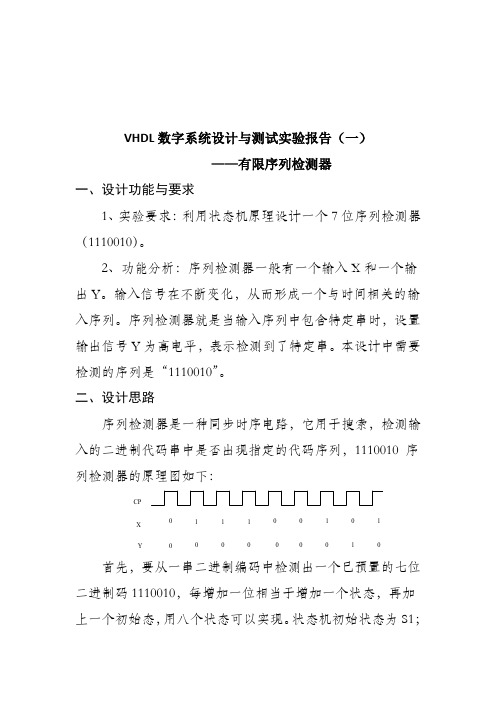
VHDL数字系统设计与测试实验报告(一)——有限序列检测器一、设计功能与要求1、实验要求:利用状态机原理设计一个7位序列检测器(1110010)。
2、功能分析:序列检测器一般有一个输入X和一个输出Y。
输入信号在不断变化,从而形成一个与时间相关的输入序列。
序列检测器就是当输入序列中包含特定串时,设置输出信号Y为高电平,表示检测到了特定串。
本设计中需要检测的序列是“1110010”。
二、设计思路序列检测器是一种同步时序电路,它用于搜索,检测输入的二进制代码串中是否出现指定的代码序列,1110010 序列检测器的原理图如下:CPX Y 0111010010010首先,要从一串二进制编码中检测出一个已预置的七位二进制码1110010,每增加一位相当于增加一个状态,再加上一个初始态,用八个状态可以实现。
状态机初始状态为S1;当自动机接收到一个“1”时,自动机进入S2状态;如果在S2状态接收到“1”时,自动机进入到S3状态;如果在S3状态接收到“1”时,自动机进入到S4状态;如果在S4状态接收到“0”时,自动机进入到S5状态;如果在S5状态接收到“0”时,自动机进入到S6状态;如果在S6状态接收到“1”时,自动机进入到S7状态;如果在S7状态接收到“0”时,自动机进入到S8状态;如果自动机处于S8状态,则表示接收到了一个连续的串“1110010”,此时可以设置输出信号为高电平。
其Moore型原始状态转移图如下:根据状态转移图可以得出Moore型原始状态转移表为:三、源代码library ieee;use ieee.std_logic_1164.all;entity checkerarray isport(din:in std_logic;clk,clr:in std_logic;z:buffer std_logic);end checkerarray;architecture arch_check of checkerarray is type StateType is(s1,s2,s3,s4,s5,s6,s7,s8);signal present_state,next_state:StateType; beginstate_comb:process(present_state,din)begincase present_state iswhen s1=>z<='0';if din='1'thennext_state<=s2;elsenext_state<=s1;end if;when s2=>z<='0';if din='1'thennext_state<=s3;elsenext_state<=s2;end if;when s3=>z<='0';if din='1'thennext_state<=s4;elsenext_state<=s1;end if;when s4=>z<='0';if din='1'thennext_state<=s4;elsenext_state<=s5;end if;when s5=>z<='0';if din='1'thennext_state<=s2;elsenext_state<=s6;end if;when s6=>z<='0';if din='1'thennext_state<=s7;elsenext_state<=s1;end if;when s7=>z<='0';if din='1'thennext_state<=s3;elsenext_state<=s8;end if;when s8=>z<='1';if din='1'thennext_state<=s2;elsenext_state<=s1;end if;end case;end process state_comb;state_clocked:process(clk,clr) beginif(clr='1')thenpresent_state<=s1;elsif(clk'event and clk='1')thenpresent_state<=next_state;end if;end process state_clocked;end arch_check;四、仿真结果与说明上图即为在modelsim中进行仿真的波形图像。
实验三_用状态机实现序列检测器的设计

实验三_用状态机实现序列检测器的设计引言:序列检测器是一类常用的电子设计电路,它在接收到特定的输入序列时,会产生特定的输出序列。
在许多应用场景中,如通信系统、数字信号处理和自动控制等领域,序列检测器都发挥着重要的作用。
本实验将利用状态机的概念,设计并实现一个简单的序列检测器。
一、序列检测器的设计原理序列检测器的设计原理基于状态机的思想。
状态机是一种抽象的计算模型,它由一组状态、一组输入和一组转移动作组成。
在序列检测器中,输入序列被连续地输入,状态也会根据输入进行不断变化。
当状态机检测到了预设的特定输入序列时,就会产生相应的输出序列。
二、序列检测器的设计步骤1.确定输入和输出序列:首先确定所需检测的输入序列和对应的输出序列,这将决定状态机的状态转移条件。
2.绘制状态转移图:根据输入和输出序列,绘制状态转移图,即用状态变量和状态转移条件表示状态转移关系。
3.设计状态机的状态转移表:根据状态转移图,将所有可能的状态转移关系整理为一个状态转移表。
4.实现状态机的代码逻辑:根据状态转移表,编写代码实现状态机的逻辑功能。
三、设计实例在本实验中,我们以一个简单示例为例,演示序列检测器的设计流程。
假设输入序列为0101,当检测到该输入序列时,输出序列为011.确定输入和输出序列:输入序列为0101,输出序列为012.绘制状态转移图:根据输入和输出序列,绘制状态转移图如下:0/00,S0,1/1/1说明:状态S0表示未检测到特定输入序列,状态S1表示检测到特定输入序列。
3.设计状态机的状态转移表:根据状态转移图,得到状态转移表如下:输当前状态,0,1S0,S0,S1S1,S0,S14.实现状态机的代码逻辑:根据状态转移表,编写代码实现状态机的逻辑功能,伪代码如下:if (当前状态 == S0)if (输入 == 0)当前状态=S0;输出=0;} else if (输入 == 1)当前状态=S1;输出=0;}} else if (当前状态 == S1)if (输入 == 0)当前状态=S0;输出=1;} else if (输入 == 1)当前状态=S1;输出=1;}}四、实验总结本实验利用状态机的思想,设计并实现了一个简单的序列检测器。
HDL课程设计序列检测器的设计
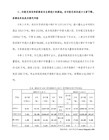
课程设计项目成绩评定表设计项目成绩评定表课程设计报告书目录设计报告书目录一、设计目的 (1)二、设计思路 (1)三、设计过程 (1)3.1、设计原理 (1)3.2、设计模块 (2)3.3、测试模块 (3)四、仿真结果 (4)五、主要元器件与设备 (4)六、课程设计体会与建议 (4)6.1、设计体会 (4)6.2、设计建议 (5)七、参考文献 (5)一、设计目的1、熟练掌握Verilog 语言。
2、熟悉HDL数字系统的设计流程。
二、设计思路1、设计功能设计模块。
2、设计测试代码。
三、设计过程3.1、设计原理序列检测器可用于检测一组或多组由二进制码组成的脉冲序列信号,当序列检测器连续收到一组串行二进制码后,如果这组码与检测器中预先设置的码相同,则输出1,否则输出0。
由于这种检测的关键在于正确码的收到必须是连续的,这就要求检测器必须记住前一次的正确码及正确序列,知道在连续的检测中所收到的每一位码都与预置数的对应码相同。
在检测过程中,任何一位不相等都将回到初始状态重新开始检测。
序列检测器在数据通讯,雷达和遥测等领域中用与检测步识别标志。
它是一种用来检测一组或多组序列信号的电路。
例如检测器收到一组串行码{10010}后,输出标志1,否则,输出0。
考查这个例子,每收到一个符合要求的串行码就需要用一个状态进行记忆。
串行码长度为5位,需要5个状态;另外,还需要增加一个“未收到一个有效位”的状态,共6个状态;S0~S5,状态标记符的下标表示有几个有效位被读出。
画出状态转换图,如图1所示,很显然这是一个莫尔状态机。
6个状态机根据编码原则可以用3位二进制数来表示。
图1状态转换图3.2、设计模块module series(clk,x,z,rst); //series detectinput clk,rst;input x;output z;reg[2:0] state;parameter idle=3'd0,A=3'd1,B=3'd2,C=3'd3,D=3'd4,E=3'd5;assign z=(state==E)?1:0;always@(posedge clk)beginif(!rst)state<=idle;elsecase(state)idle:if(x==1)state<=A;elsestate<=idle;A: if(x==0)state<=B;elsestate<=A;B: if(x==0)state<=C;elsestate<=A;C: if(x==1)state<=D;elsestate<=idle;D: if(x==0)state<=E;elsestate<=A;E: if(x==1)state<=A;elsestate<=C;default: state<=idle;endcaseendendmodule3.3、测试模块module detecttest;reg clk,rst;reg x;reg[20:0] data;wire z;initialbeginclk=0;rst=0;#30 rst=1;data=20'b1100_1001_0000_1001_0100;endalways #10 clk=~clk;always@(posedge clk)data={data[19:0],data[20]};always@(posedge clk)x=data[20];series lut(.clk(clk),.rst(rst),.x(x),.z(z));endmodule四、仿真结果图2序列检测器仿真图当时钟上升沿来临时开始检测,信号从x输入,有信号输入时的下一时钟上升沿开始检测,从图2中可知在第五个上升沿来临时正好检测到一连续串行序列10010立即出现高电平,所以可知设计的程序完全符合要求。
实验三_用状态机实现序列检测器的设计

实验三_用状态机实现序列检测器的设计
一、实验目的
①了解序列检测器的基本原理;
②使用状态机模型设计序列检测器;
③理解状态机的工作原理,以及应用状态机设计逻辑电路的思想与方法。
二、实验原理
序列检测器,又称序列检测器或序列检测装置,是将输入的序列信号,与一个事先给定的序列模式进行比较,以判断输入信号是否与给定的模式
相匹配。
当输入信号与给定模式完全匹配时,则检测出一个正确的模式序列。
如果输入的信号不与模式相匹配,则认为出错,并给出错误信号。
序列检测器有很多的组成部分,包括输出寄存器,状态寄存器,比较
状态机,其中比较状态机是序列检测器最重要的组成部分。
它主要功能是:获取模式序列,比较模式和输入序列,并根据比较结果生成对应的输出信号。
具体来说,比较状态机包括:输入处理模块,状态比较模块,指令控
制模块和输出触发模块。
三、实验内容
1、设计一个比较状态机,用于检测并确定序列是否与给定的模式序
列相同。
2、使用VHDL绘制比较状态机的模型,并编写代码实现。
3、真实应用比较状态机,设计一个校验器,用于检测序列是否符合一定的校验规则。
序列检测器设计-modelsim-verilog-实验报告
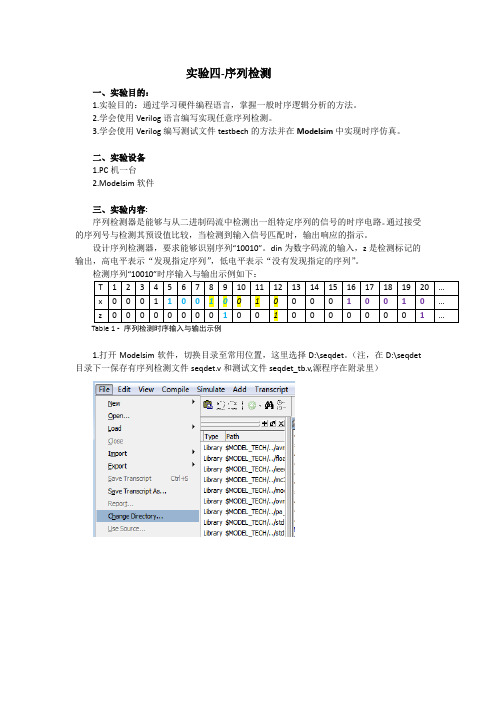
实验四-序列检测一、实验目的:1.实验目的:通过学习硬件编程语言,掌握一般时序逻辑分析的方法。
2.学会使用Verilog语言编写实现任意序列检测。
3.学会使用Verilog编写测试文件testbech的方法并在Modelsim中实现时序仿真。
二、实验设备1.PC机一台2.Modelsim软件三、实验内容:序列检测器是能够与从二进制码流中检测出一组特定序列的信号的时序电路。
通过接受的序列号与检测其预设值比较,当检测到输入信号匹配时,输出响应的指示。
设计序列检测器,要求能够识别序列“10010”。
din为数字码流的输入,z是检测标记的输出,高电平表示“发现指定序列”,低电平表示“没有发现指定的序列”。
1.打开Modelsim软件,切换目录至常用位置,这里选择D:\seqdet。
(注,在D:\seqdet 目录下一保存有序列检测文件seqdet.v和测试文件seqdet_tb.v,源程序在附录里)2.然后新建工程,File ->New->Project,建立工程工程为seqdet,设置如下,并在接下来的步骤中添加序列检测文件seqdet.v和测试文件seqdet_tb.v。
4.编译文件编译无误后,进行仿真5.文件仿真在弹出的窗口中选择Design->work->seqdet_tb,默认选中优化选项。
选择OK6.添加信号到wave视图中。
在仿真状态下,切换到左侧导航窗口到object视图下,添加信号T,clk,rst,x,z,q到wave窗口中,添加完成后如图所示:7.运行仿真至1000ns,,波形图显示如图所示:8.结果分析:对上述图形分析如下,用蓝色表示的为第一次检测到匹配序列“10010”,黄色表示为第二次匹配序列,紫色表示为第三次匹配序列。
z分别在这三处匹配时输出高电平,其他为低电平,实现了序列检测的功能。
四,程序:①源程序模块seqdet.v :module seqdet(input wire x, //信号输入input wire clk, //时钟信号input wire rst,output wire z,output reg [4:0] q //序列输出);wire [4:0] q_next;assign q_next ={q[3:0],x};assign z = (q_next== 5'b10010) ? 1'b1:1'b0;always @ (posedge clk,negedge rst)if(!rst)q <= 5'd0;elseq <= q_next;endmodule②测试程序模块seqdet_tb.v`timescale 1ns/1nsmodule seqdet_tb;localparam T =20;reg clk,rst;reg [23:0] data;wire z,x;wire [4:0] q;assign x = data[23];initialbeginclk =0;rst =1;#2 rst =0;#30 rst =1;data =20'b1100_1001_0000_1001_0100;#(T*1000) $stop;endalways #T clk = ~clk;always @ (posedge clk)#2 data = {data[22:0],data[23]};seqdet U1(.x(x),.z(z),.clk(clk),.q(q),.rst(rst));endmodule五、实验总结:通过本次实验,对Verilog硬件描述语言有了进一步认识,学会编写verilog语言的文本设计方法,并学会编写testbench测试程序。
课程设计序列检测器的设计
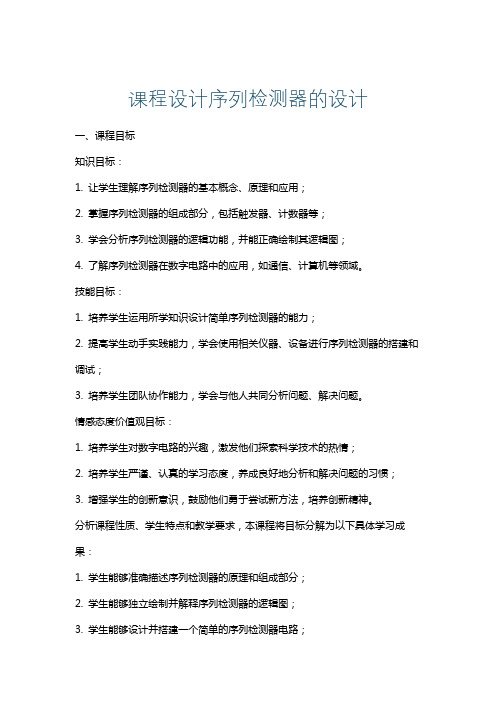
课程设计序列检测器的设计一、课程目标知识目标:1. 让学生理解序列检测器的基本概念、原理和应用;2. 掌握序列检测器的组成部分,包括触发器、计数器等;3. 学会分析序列检测器的逻辑功能,并能正确绘制其逻辑图;4. 了解序列检测器在数字电路中的应用,如通信、计算机等领域。
技能目标:1. 培养学生运用所学知识设计简单序列检测器的能力;2. 提高学生动手实践能力,学会使用相关仪器、设备进行序列检测器的搭建和调试;3. 培养学生团队协作能力,学会与他人共同分析问题、解决问题。
情感态度价值观目标:1. 培养学生对数字电路的兴趣,激发他们探索科学技术的热情;2. 培养学生严谨、认真的学习态度,养成良好地分析和解决问题的习惯;3. 增强学生的创新意识,鼓励他们勇于尝试新方法,培养创新精神。
分析课程性质、学生特点和教学要求,本课程将目标分解为以下具体学习成果:1. 学生能够准确描述序列检测器的原理和组成部分;2. 学生能够独立绘制并解释序列检测器的逻辑图;3. 学生能够设计并搭建一个简单的序列检测器电路;4. 学生能够运用所学知识分析并解决实际数字电路问题;5. 学生在团队协作中,能够积极参与、沟通、分享,共同完成任务。
二、教学内容本章节教学内容依据课程目标,结合教材第二章“数字电路基础”相关内容,组织以下教学大纲:1. 序列检测器原理及分类- 序列检测器的基本概念- 序列检测器的工作原理- 序列检测器的分类及应用2. 序列检测器的组成部分- 触发器的类型与功能- 计数器的作用与分类- 逻辑门电路的基本原理3. 序列检测器逻辑设计与分析- 逻辑图的绘制方法- 序列检测器逻辑设计步骤- 常见序列检测器逻辑分析实例4. 序列检测器应用案例- 通信系统中序列检测器的应用- 计算机领域中的序列检测器- 其他数字电路中的实际应用案例5. 实践操作:序列检测器设计与搭建- 设计一个简单的序列检测器电路- 使用仪器、设备进行电路搭建和调试- 分析实验结果,优化设计方案教学内容安排和进度如下:第1周:序列检测器原理及分类第2周:序列检测器的组成部分第3周:序列检测器逻辑设计与分析第4周:序列检测器应用案例及实践操作三、教学方法针对本章节内容,采用以下多样化的教学方法,以激发学生的学习兴趣和主动性:1. 讲授法:教师以教材为依据,系统讲解序列检测器的基本概念、原理、分类及应用。
实验五用状态机实现序列检测器的设计
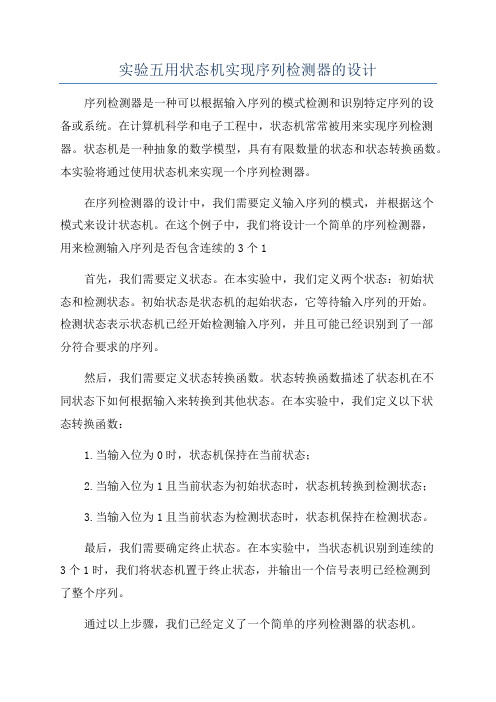
实验五用状态机实现序列检测器的设计序列检测器是一种可以根据输入序列的模式检测和识别特定序列的设备或系统。
在计算机科学和电子工程中,状态机常常被用来实现序列检测器。
状态机是一种抽象的数学模型,具有有限数量的状态和状态转换函数。
本实验将通过使用状态机来实现一个序列检测器。
在序列检测器的设计中,我们需要定义输入序列的模式,并根据这个模式来设计状态机。
在这个例子中,我们将设计一个简单的序列检测器,用来检测输入序列是否包含连续的3个1首先,我们需要定义状态。
在本实验中,我们定义两个状态:初始状态和检测状态。
初始状态是状态机的起始状态,它等待输入序列的开始。
检测状态表示状态机已经开始检测输入序列,并且可能已经识别到了一部分符合要求的序列。
然后,我们需要定义状态转换函数。
状态转换函数描述了状态机在不同状态下如何根据输入来转换到其他状态。
在本实验中,我们定义以下状态转换函数:1.当输入位为0时,状态机保持在当前状态;2.当输入位为1且当前状态为初始状态时,状态机转换到检测状态;3.当输入位为1且当前状态为检测状态时,状态机保持在检测状态。
最后,我们需要确定终止状态。
在本实验中,当状态机识别到连续的3个1时,我们将状态机置于终止状态,并输出一个信号表明已经检测到了整个序列。
通过以上步骤,我们已经定义了一个简单的序列检测器的状态机。
下面是一个简单的状态机实现的示例代码:```#define INITIAL_STATE 0#define DETECTION_STATE 1#define TERMINATE_STATE 2int state = INITIAL_STATE;int count = 0;void detect_sequence(int input)switch(state)case INITIAL_STATE:if (input == 1)state = DETECTION_STATE;count = 1;}break;case DETECTION_STATE:if (input == 1)count++;if (count == 3)state = TERMINATE_STATE;output_signal(;}} elsestate = INITIAL_STATE;count = 0;}break;case TERMINATE_STATE:// do nothingbreak;}void output_signa// output signal here```在上述代码中,我们使用一个整型变量`state`来表示状态,一个整型变量`count`来表示检测到的连续1的数量。
设计序列检测器

特异性
检测器在非目标序列存在时的 抗干扰能力,即区分不同序列 的能力。
实时性
检测器对输入信号的响应速度 ,包括处理延迟和吞吐量等指 标。
可靠性
检测器在长时间运行过程中的 稳定性和一致性,以及误报率
和漏报率等性能表现。
03
序列检测器的设计方法
基于状态机的设计方法
状态定义
01
根据待检测序列的特性,定义状态机的各个状态,包括初始状
态、中间状态和终止状态。
状态转移
02
设计状态之间的转移条件,使得状态机能够按照待检测序列的
顺序进行状态转移。
输出逻辑
03
在终止状态设置相应的输出逻辑,以便在检测到目标序列时产
生相应的输出信号。
基于特征方程的设计方法
特征方程
根据待检测序列的特性,构造一个特征方程,用于描 述序列的规律。
序列生成
利用特征方程生成待检测序列,并将其与输入序列进 行比较。
序列检测器的定义和应用
定义
序列检测器是一种计算机程序或算法, 用于在输入序列中搜索和识别特定的 子序列或模式。
01
网络安全
在网络流量中检测特定的攻击模式或 恶意代码,用于网络安全防护和入侵 检测。
05
02
基因组学
在基因序列中检测特定的基因或突变, 用于疾病诊断和治疗。
03
蛋白质组学
在蛋白质序列中检测特定的功能域或 结构,用于蛋白质功能和相互作用的 研究。
为了满足不同用户的需求,未来 的序列检测器将提供更加灵活的 可定制化设计,允许用户根据自 己的需求进行个性化配置和定制。
感谢观看
THANKS
在生物医学领域的应用
1 2
设计序列检测器
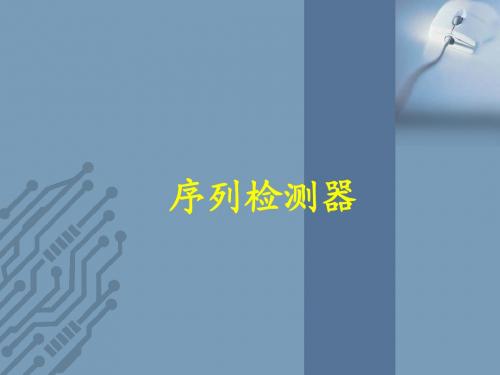
序列检测器
一. 实验目的
熟悉和掌握时序电路的设计方法。 熟悉和掌握时序电路的设计方法。
二.实验器材
• 根据设计的电路,自行详细地列出 根据设计的电路, 所需要的芯片、电阻、接线路时使用。 备连接线路时使用。
四.实验内容 • 设计一个巴克码1110010序列检测器。 设计一个巴克码1110010序列检测器。 1110010序列检测器 • 设计要求: 设计要求:
对串行输入的序列信号进行检测,当电 对串行输入的序列信号进行检测, 路输入序列连续送入1110010 1110010时 路输入序列连续送入1110010时,检测器 输出为1,指示灯亮;其他情况,检测器 输出为1 指示灯亮;其他情况, 输出都为0 输出都为0。
五.实验要求
• 写出实现巴克码1110010序列检测器的设计 写出实现巴克码1110010序列检测器的设计 1110010 思路,并列出详细的设计过程。 思路,并列出详细的设计过程。 • 画出序列检测器的电路图。 画出序列检测器的电路图。 • 接线验证电路是否符合要求。 接线验证电路是否符合要求。 • 详细说明在设计操作中遇到问题与解决方法。 详细说明在设计操作中遇到问题与解决方法。 • 对实验结果进行分析。 对实验结果进行分析。
序列检测器
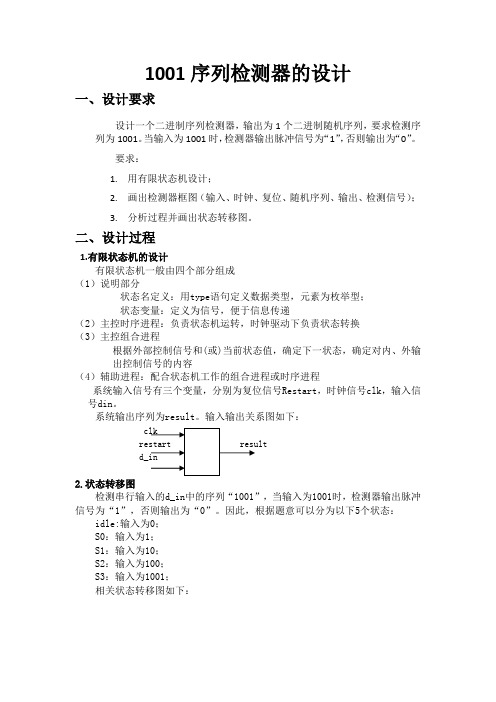
1001序列检测器的设计一、设计要求设计一个二进制序列检测器,输出为1个二进制随机序列,要求检测序列为1001。
当输入为1001时,检测器输出脉冲信号为“1”,否则输出为“0”。
要求:1.用有限状态机设计;2.画出检测器框图(输入、时钟、复位、随机序列、输出、检测信号);3.分析过程并画出状态转移图。
二、设计过程1.有限状态机的设计有限状态机一般由四个部分组成(1)说明部分状态名定义:用type语句定义数据类型,元素为枚举型;状态变量:定义为信号,便于信息传递(2)主控时序进程:负责状态机运转,时钟驱动下负责状态转换(3)主控组合进程根据外部控制信号和(或)当前状态值,确定下一状态,确定对内、外输出控制信号的内容(4)辅助进程:配合状态机工作的组合进程或时序进程系统输入信号有三个变量,分别为复位信号Restart,时钟信号clk,输入信号din。
系统输出序列为result。
输入输出关系图如下:clkd_in2.状态转移图检测串行输入的d_in中的序列“1001”,当输入为1001时,检测器输出脉冲信号为“1”,否则输出为“0”。
因此,根据题意可以分为以下5个状态:idle:输入为0;S0:输入为1;S1:输入为10;S2:输入为100;S3:输入为1001;相关状态转移图如下:3.源程序本程序在 max+plus II软件平台编写和仿真。
源程序代码如下:Library ieee;Use ieee.std_logic_1164.ALL;ENTITY s5_machine ISPORT(clk, d_in : IN STD_LOGIC ;restart : IN BOOLEAN ;result: OUT STD_LOGIC) ;END ENTITY s5_machine;ARCHITECTURE activ OF s5_machine ISTYPE state IS (idle,s0, s1, s2, s3); -- 利用程序包定义数据类型SIGNAL present_state, next_state: state ;BEGINRestart_And_Switch: PROCESS(clk, restart) -- 第一个进程BEGINIF (restart) THEN -- 监测复位信号present_state<= idle;ELSIF (clk'EVENT AND clk ='1') THEN -- 监测时钟上沿present_state<= next_state;END IF;END processRestart_And_Switch;State_Decision: PROCESS(d_in,present_state) -- 第二个进程BEGINnext_state<= s0;IF (d_in = '0') THENCASE present_state ISWHEN idle=>next_state<=idle;WHEN s0 =>next_state<= s1;WHEN s1 =>next_state<= s2;WHEN s2 =>next_state<= idle;WHEN s3 =>next_state<=idle ;END CASE;ELSIF (d_in = '1')THENCASE present_state ISWHEN idle=>next_state<= s0;WHEN s0 =>next_state<= s0;WHEN s1 =>next_state<= s0;WHEN s2 =>next_state<= s3;WHEN s3 =>next_state<=s0;end case;END IF;END processState_Decision;Output_Decision:PROCESS(present_state)--第三个进程BEGINIF (present_state=s3) thenresult<='1';ELSEresult<='0';END IF;END processOutput_Decision;end ARCHITECTURE activ;三、仿真结果在本次仿真中,输入信号d_in为时钟信号的二分频后的信号11001100,从图示结果中可以看到,当输入序列为1001且复位信号restart为0时,输出信号result高电平,结果正确。
实验八用状态机实现序列检测器的设计

实验八用状态机实现序列检测器的设计
1、实验目的
本实验旨在通过状态机的设计实现一个序列检测器,该序列检测器可
以检测01序列中可编程的模式,并实现相应的响应动作。
2、实验原理
序列检测器是一种有限状态机,由一系列状态和一系列触发器组成,
可以检测特定的序列,并拥有一定的驱动和响应动作。
根据所检测的序列,检测器通过触发器设置能够自动的转换到特定的状态,触发器的设置可以
根据需要进行调整,从而实现不同的序列和不同的响应动作。
3、实验内容
(1)状态机的设计
状态机的设计分为状态图设计和状态表设计两部分,在状态图设计中,绘制出起始状态、可能的转移状态以及相应的触发器, shown by figure 1 below . 再根据实验的要求,结合状态图和状态表,确定每一个触发器
的对应的转移状态以及响应动作, shown by table 1 below .
(2)用VHDL编程实现状态机
在VHDL中,可以实现上面的状态机,用自定义的类型定义状态、触
发器、响应动作以及转移条件,将状态图转换成可执行的VHDL代码,shown by listing 1 below .
(3)VHDL代码的仿真
在仿真中,可以根据状态图测试序列检测器的功能,确保能够检测出正确的模式,并实现预期的响应动作, shown by figure 2 below.
4、实验结果。
实验五用状态机实现序列检测器的设计

实验五用状态机实现序列检测器的设计
一、背景简介
序列检测器是用来检测输入字符串中是否存在特定序列的字符串检测器。
在现代的工业控制中,序列检测器的应用十分广泛,例如机器操作指令的检测,机器人的动作序列检测,机械手的加工步骤检测等等,它们可以用在几乎所有的自动控制系统中,既提高了系统的可靠性,又提高了系统的运行效率。
二、状态机实现序列检测器
1)概念介绍
状态机是一种形式语言,它用于模拟系统的状态和行为,并用来表示系统的变化,可以用于描述和分析控制系统的性能。
根据状态机的不同表示形式,可以分为状态转换表,状态转移图,状态转移矩阵,状态表和状态图。
采用状态机实现序列检测器,首先需要建立一个状态机图,状态机图需要有起点和终点,以及从一个状态到另一个状态的转移规则。
根据输入的字符串,每次转移到下一个状态,直到终止状态,如果在该过程中没有终止状态,或终止状态不是指定的终止状态,则检测字符串不包含特定的序列字符。
2)具体实现。
序列检测器的设计实验报告

序列检测器的设计实验报告一、实验目的本次实验的目的是设计一个能够检测特定序列的数字逻辑电路,即序列检测器。
通过设计和实现这个电路,深入理解数字电路的基本原理和设计方法,掌握状态机的概念和应用,提高逻辑分析和电路设计的能力。
二、实验原理序列检测器是一种能够在输入数据流中检测特定序列的电路。
它通常由状态机实现,状态机根据输入的变化在不同的状态之间转移,并在特定的状态下输出检测结果。
以检测序列“1011”为例,我们可以定义以下几个状态:状态 S0:初始状态,等待输入。
状态 S1:接收到“1”,等待下一个输入。
状态 S2:接收到“10”,等待下一个输入。
状态 S3:接收到“101”,等待下一个输入。
状态 S4:接收到“1011”,输出检测成功信号。
根据状态转移和输出的规则,可以画出状态转移图,并根据状态转移图设计相应的逻辑电路。
三、实验设备与器材1、数字电路实验箱2、逻辑门芯片(如与门、或门、非门等)3、示波器4、电源四、实验步骤1、分析设计要求,确定状态转移和输出规则,画出状态转移图。
2、根据状态转移图,列出状态转换表,确定每个状态下的输入和输出。
3、使用卡诺图或其他逻辑化简方法,对状态转换表进行化简,得到最简的逻辑表达式。
4、根据逻辑表达式,选择合适的逻辑门芯片,在实验箱上搭建电路。
5、连接电源和示波器,对电路进行测试。
输入不同的序列,观察输出是否符合预期。
五、实验电路设计以下是检测序列“1011”的逻辑电路设计:状态变量定义:设当前状态为 Q1Q0,其中 Q1 为高位,Q0 为低位。
状态转移方程:Q1(n+1) = Q1Q0 + XQ1' (其中 X 为输入)Q0(n+1) = XQ0' + Q1Q0输出方程:Y = Q1Q0X根据上述方程,使用与门、或门和非门搭建电路。
六、实验结果与分析在实验中,输入了不同的序列,包括“1011”以及其他随机序列。
通过示波器观察输出,当输入序列为“1011”时,输出为高电平,表示检测成功;当输入其他序列时,输出为低电平,表示未检测到目标序列。
10位序列检测器设计
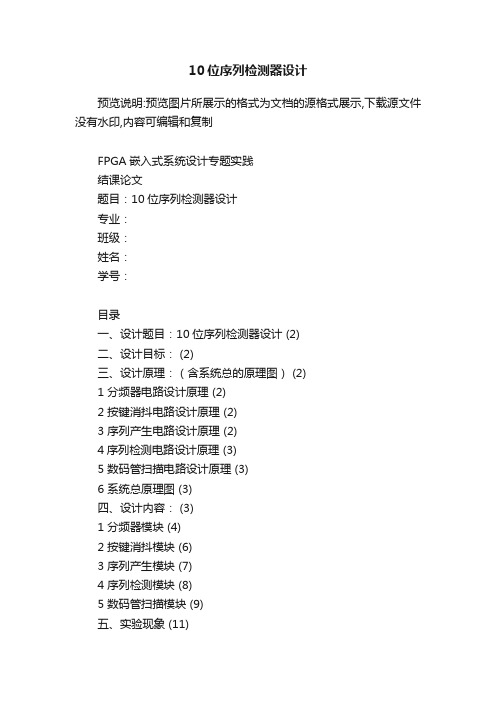
10位序列检测器设计预览说明:预览图片所展示的格式为文档的源格式展示,下载源文件没有水印,内容可编辑和复制FPGA嵌入式系统设计专题实践结课论文题目:10位序列检测器设计专业:班级:姓名:学号:目录一、设计题目:10位序列检测器设计 (2)二、设计目标: (2)三、设计原理:(含系统总的原理图) (2)1 分频器电路设计原理 (2)2 按键消抖电路设计原理 (2)3 序列产生电路设计原理 (2)4序列检测电路设计原理 (3)5 数码管扫描电路设计原理 (3)6 系统总原理图 (3)四、设计内容: (3)1 分频器模块 (4)2 按键消抖模块 (6)3 序列产生模块 (7)4 序列检测模块 (8)5 数码管扫描模块 (9)五、实验现象 (11)六、实验感想 (11)一、设计题目:10位序列检测器设计二、设计目标:1、熟练掌握Quartus II 的使用方法及VHDL的编程方法。
2、掌握有限状态机的工作原理3、熟悉串行信号的输入和扫描。
4、理解在多状态情况下的状态选择和控制。
三、设计原理:(含系统总的原理图)1 分频器电路设计原理对时钟进行偶数分频的话,使占空比为50%。
只要使用一个计数器,在计数器的前一半时间使输出为高电平,在计数器的后一半时间使输出为低电平,即可得到偶分频时钟。
对时钟进行奇数分频的话,使占空比为50%。
先对输入时钟的上升沿进行计数,让一个内部信号在前一半时间(分频系数除2取整)为高电平,后一半时间为低电平;再对输入时钟的下降沿进行计数,让另一个内部信号在前一半时间为高电平,后一半时间为低电平;然后将这内部两个信号相或后即得到奇数分频时钟。
2 按键消抖电路设计原理对一个按键信号,对它进行取样,如果连续两次取样都为低电平,则认为信号已经处于稳定状态,这时输出一个低电平的按键信号。
否则只要有一次取样不为低电平,则认为是抖动,将其丢弃。
由于按键抖动的时间一般为5到10ms,因此输入时钟clk使用对48M系统时钟分频得到200Hz时钟脉冲(周期为5ms),即5ms采样一次按键信号,当连续两次采样到的按键信号都为低电平时,认为按键稳定的按下。
EDA序列检测器设计课程设计

EDA序列检测器设计课程设计一、课程目标知识目标:1. 让学生理解EDA序列检测器的基本原理和设计流程;2. 掌握数字电路设计的基本方法,并能运用所学知识分析EDA序列检测器的功能;3. 了解EDA工具的使用,如原理图绘制、仿真测试等。
技能目标:1. 培养学生运用所学知识进行EDA序列检测器设计的能力;2. 提高学生实际操作EDA工具,解决实际问题的能力;3. 培养学生的团队协作能力和沟通表达能力。
情感态度价值观目标:1. 培养学生对电子设计自动化(EDA)技术的兴趣和热情;2. 增强学生的创新意识,培养敢于挑战、勇于实践的精神;3. 培养学生严谨、务实的科学态度,养成良好的学习习惯。
课程性质:本课程为电子技术实践课程,旨在培养学生的实际操作能力和创新能力。
学生特点:学生已经掌握了数字电路基础知识,具有一定的电路分析和设计能力。
教学要求:结合课本内容,注重理论与实践相结合,强调实际操作和团队协作。
在教学过程中,将目标分解为具体的学习成果,以便进行教学设计和评估。
通过本课程的学习,使学生能够独立完成EDA序列检测器的设计与仿真。
二、教学内容1. 数字电路基础知识回顾:逻辑门、触发器、计数器等基本概念和功能;2. EDA工具介绍:原理图绘制、电路仿真、PCB设计等;3. 序列检测器原理:Moore状态机、Mealy状态机设计方法;4. 序列检测器设计流程:需求分析、状态划分、状态转移图绘制、输出逻辑设计;5. 序列检测器仿真与测试:使用EDA工具进行原理图绘制、仿真测试及优化;6. 实际操作:分组进行EDA序列检测器设计,交流与展示;7. 课程总结与评价:对所学内容进行总结,评估学生的学习成果。
教学内容安排与进度:1. 第一周:数字电路基础知识回顾,EDA工具介绍;2. 第二周:序列检测器原理,设计流程讲解;3. 第三周:分组进行序列检测器设计,指导与答疑;4. 第四周:完成序列检测器仿真与测试,进行展示与评价。
实验四序列检测器的设计
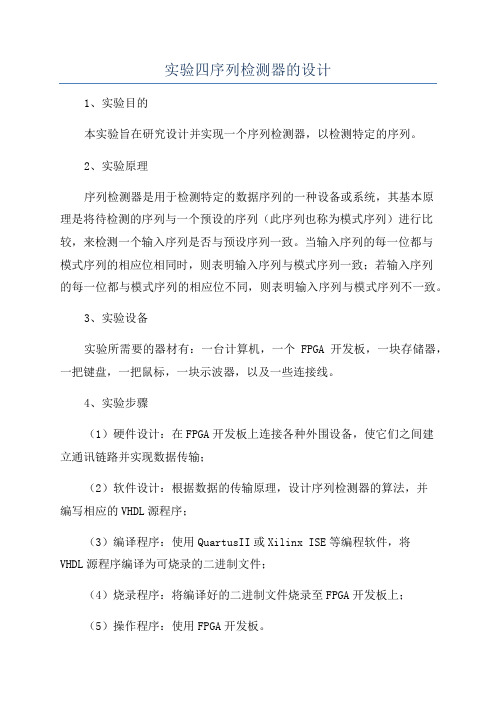
实验四序列检测器的设计
1、实验目的
本实验旨在研究设计并实现一个序列检测器,以检测特定的序列。
2、实验原理
序列检测器是用于检测特定的数据序列的一种设备或系统,其基本原
理是将待检测的序列与一个预设的序列(此序列也称为模式序列)进行比较,来检测一个输入序列是否与预设序列一致。
当输入序列的每一位都与
模式序列的相应位相同时,则表明输入序列与模式序列一致;若输入序列
的每一位都与模式序列的相应位不同,则表明输入序列与模式序列不一致。
3、实验设备
实验所需要的器材有:一台计算机,一个FPGA开发板,一块存储器,一把键盘,一把鼠标,一块示波器,以及一些连接线。
4、实验步骤
(1)硬件设计:在FPGA开发板上连接各种外围设备,使它们之间建
立通讯链路并实现数据传输;
(2)软件设计:根据数据的传输原理,设计序列检测器的算法,并
编写相应的VHDL源程序;
(3)编译程序:使用QuartusII或Xilinx ISE等编程软件,将
VHDL源程序编译为可烧录的二进制文件;
(4)烧录程序:将编译好的二进制文件烧录至FPGA开发板上;
(5)操作程序:使用FPGA开发板。
- 1、下载文档前请自行甄别文档内容的完整性,平台不提供额外的编辑、内容补充、找答案等附加服务。
- 2、"仅部分预览"的文档,不可在线预览部分如存在完整性等问题,可反馈申请退款(可完整预览的文档不适用该条件!)。
- 3、如文档侵犯您的权益,请联系客服反馈,我们会尽快为您处理(人工客服工作时间:9:00-18:30)。
6
序列检测器的VHDL语言描述 语言描述 序列检测器的
architecture fsm of FSM_sequence_detector is type states is (s0,s1,s2,s3,s4,s5,s6,s7); signal state: states:=s0; begin process(xi,state) begin if clk'event and clk='1' then case state is when s0=>output<='0'; if(xi='1') then state<=s1; else state<=s0; end if;
11
序列检测器的功能仿真结果
12
课堂练习——序列检测器设计
1
序列检测器设计
• 序列检测器是时序逻辑中的经典问题 • 序列检测器一般有一个输入X和一个输出Y。输入信号在 不断变化,从而形成一个与时间相关的输入序列。序列检 测器就是当输入序列中包含特定串时,设置输出信号Y为 高电平,表示检测到了特定串。 • 本设计中需要检测的序列是“1110010”
8
序列检测器的VHDL语言描述 语言描述 序列检测器的
when s4=>output<='0'; if(xi='0') then state<=s5; else state<=s1; end if; when s5=>output<='0'; if(xi='1') then state<=s6; else state<=s0; end if; when s6=>output<='0'; if(xi='0') then state<=s7; else state<=s2; end if;
7
序列检测器的VHDL语言描述 语言描述 序列检测器的
when s1=>output<='0'; if(xi='1') then state<=s2; else state<=s0; end if; when s2=>output<='0'; if(xi='1') then state<=s3; else state<=s0; end if; when s3=>output<='0'; if(xi='0') then state<=s4; else state<=s3; end if;
4
序列检测器的设计难点在于各种状态在各种输入情 况下的下一状态设计
• 再如S4状态,由于进入S4状态前的输入序列为“1110”, 因此如果在S4 状态下输入“1”,则表示当前输入序列为 “11101”,考察待检测序列为“1110010”,可以发现实 际输入了“1”,就知道此时状态机应转移到S1状态 • 为了更清晰的表示各个状态之间的关系,应画出状态转换 图
• 这就首先得到了有限状态机的基本框架。 这就首先得到了有限状态机的基本框架。
3
序列检测器的设计难点在于各种状态在各种进入S3状态表示前一输入为“1”, 因此如果在S3状态下输入“1”,则表示当前三个输入为 “111”,考察待检测序列为“1110010”,就知道此时状态 机应保持S3状态
9
序列检测器的VHDL语言描述 语言描述 序列检测器的
when s7=>output<='1'; if (xi='0') then state<=s0; else state<=s1; end if; end case; end if; end process; end fsm;
10
序列检测器的功能仿真波形的建立
5
序列检测器的VHDL语言描述 语言描述 序列检测器的
library ieee; use ieee.std_logic_1164.all; entity FSM_sequence_detector is port(clk,xi: in std_logic; output: out std_logic ); end FSM_sequence_detector;
2
序列检测器设计的关键是设计相应的 有限状态自动机
• • • • • • • • • 自动机初始状态为S0; 当自动机接收到一个“1”时,自动机进入S1状态; 如果在S1状态接收到“1”时,自动机进入到S2状态; 如果在S2状态接收到“1”时,自动机进入到S3状态; 如果在S3状态接收到“0”时,自动机进入到S4状态; 如果在S4状态接收到“0”时,自动机进入到S5状态; 如果在S5状态接收到“1”时,自动机进入到S6状态; 如果在S6状态接收到“0”时,自动机进入到S7状态; 如果自动机处于S7状态,则表示接收到了一个连续的串 “1110010”,此时可以设置输出信号为高电平;
